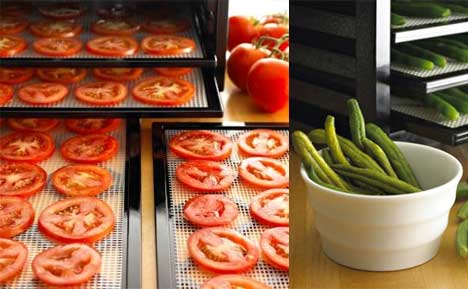Food Dehydrator Basics

A food dehydrator is just one of many ‘tools’ and methods used to preserve food for preparedness. While no single method is ideal for all circumstances, a diversified approach to food preservation is recommended.
The following is an overview of the food dehydrator and the advantages thereof…
What Is A Food Dehydrator?
A food dehydrator is a unique low temperature oven, typically with a built-in fan that moves air over the food as it slowly draws out the moisture content so as to dry it and preserve it for shelf life longevity.
A food dehydrator will typically include the following components:
-The containment shell (various shapes and materials)
-Food trays (typically a non-stick surface)
-A heater (proper temperature without ‘cooking’)
-A fan (stagnant air will saturate with moisture)
-Temperature thermostat (adjustable for food types)
-On/Off timer (not all models have this)
The temperatures to dehydrate food typically range from 125 to 155 degrees Fahrenheit depending on the type of food.
125 (Vegetables)
135 (Fruits)
155 (Jerkey)
The function of a food dehydrator is to simply remove moisture content from the food…
…without cooking it!
The advantages of a food dehydrator include the following:
One of the best reviewed food dehydrators is the ‘Excalibur’ (there are several models).
I have owned one for quite a number of years with excellent results.
Excalibur 9 Tray Deluxe Dehydrator
The Food Dehydrator Advantage
To preserve foods! Shelf life depends on food type and storage method. Generally 1 year or much longer.
Food maintains up to 95% of its nutrients.
Economical operation (e.g. an Excalibur filled with 9 trays, 15 square feet, a 10-hour batch will consume about 6kW hours of electricity costing about 90 cents).
Save money on groceries, (buy fresh fruit and vegetables or even frozen veggies when on sale at the grocery store and dehydrate them).
Dehydrate Meat or Fish for Jerky.
Related: How To Dehydrate Chicken Strips
Make animal/pet treats (chicken/turkey/beef strips).
Eat fresh fruit and vegetables in the middle of winter.
Enables more home grown garden food to eat year round.
Compact food storage (foods shrink smaller and will store in a smaller space).
Easy to pack for trips or kit.
Great tasting food (no flavor is removed during the dehydration process – only water is removed, leaving 100 percent of the flavor intact).
Let’s hear from you… Which food dehydrator do you have and what are your experiences? Favorite things to dehydrate? Do’s and Don’ts?
